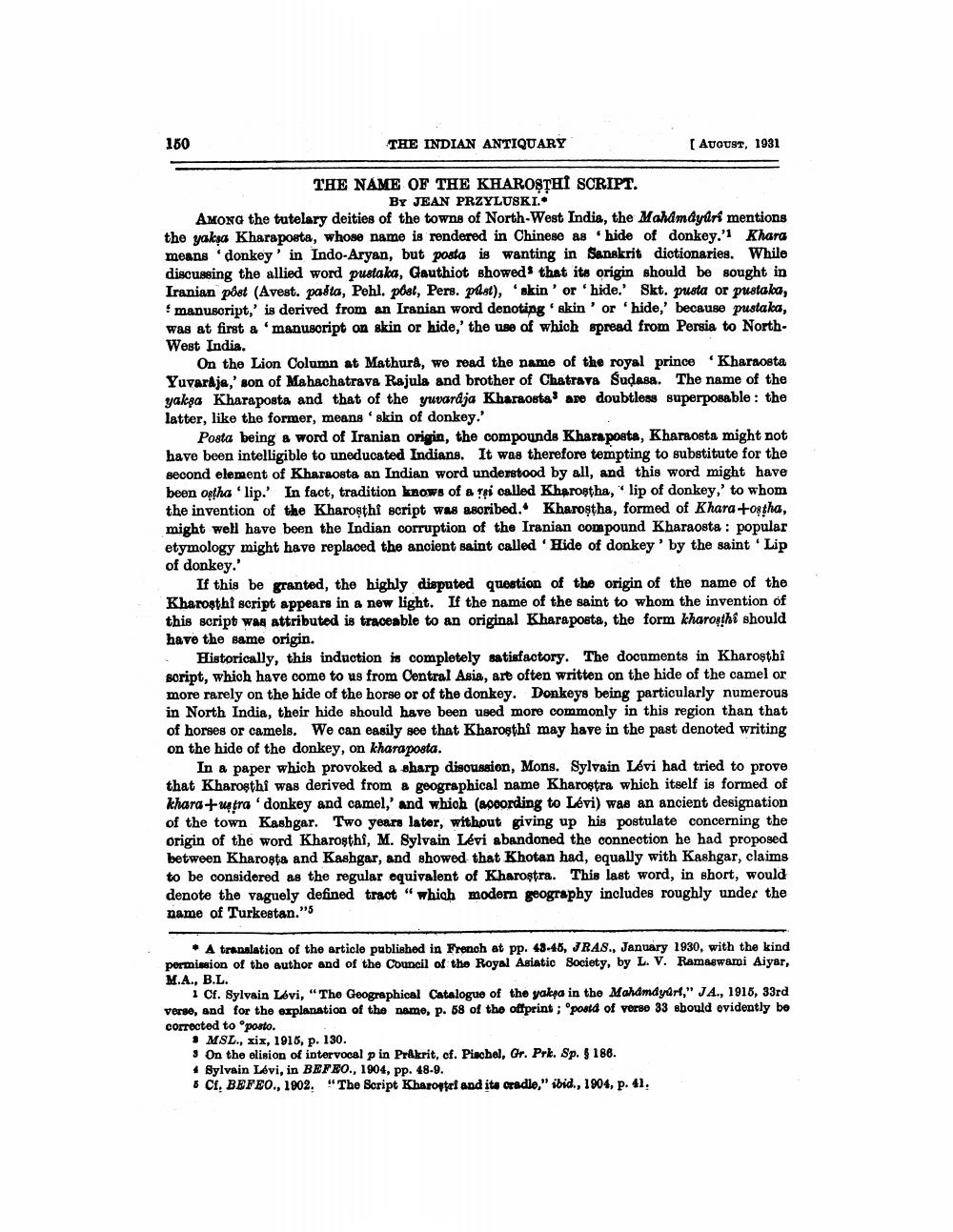________________
160
THE INDIAN ANTIQUARY
[ AUGUST, 1931
THE NAME OF THE KHAROSTHI SCRIPT.
BY JEAN PRZYLUSKI. AMONG the tutelary deities of the towns of North-West India, the Mahdmdytri mentions the yaksa Kharaposta, whose name is rendered in Chinese as hide of donkey.' Khara means 'donkey' in Indo-Aryan, but posta is wanting in Sanskrit dictionaries. While discussing the allied word pustaka, Gauthiot showed that its origin should be sought in Iranian pôst (Avest. pašta, Pehl. post, Pers. pist), 'skin' or 'hide. Skt. pusta or pustaka,
manuscript,' is derived from an Iranian word denoting skin or hide,' because pustaka, was at first a 'manuscript on skin or hide,' the use of which spread from Persia to NorthWest India.
On the Lion Column at Mathura, we read the name of the royal prince 'Kharaosta Yuvardja,' son of Mahachatrava Rajula and brother of Chatrava Sudasa. The name of the yakşa Kharaposta and that of the yuvaraja Kharaosta: ape doubtless superposable: the latter, like the former, means skin of donkey.'
Posta being a word of Iranian origin, the compounds Khara posta, Kharaosta might not have been intelligible to uneducated Indians. It was therefore tempting to substitute for the second element of Kharaosta an Indian word understood by all, and this word might have been ontha 'lip.' In fact, tradition knows of a tri called Kharostha, lip of donkey,' to whom the invention of the Kharoşthf script was ascribed. Kharoştha, formed of Khara toptha, might well have been the Indian corruption of the Iranian compound Kharaosta : popular etymology might have replaced the ancient saint called 'Hide of donkey' by the saint Lip of donkey.'
If this be granted, the highly disputed question of the origin of the name of the Kharosthi script appears in a new light. If the name of the saint to whom the invention of this script was attributed is traceable to an original Khara posta, the form kharopthi should have the same origin.
Historically, this induction is completely satisfactory. The documents in Kharostbi soript, which have come to us from Central Asia, are often written on the hide of the camel or more rarely on the hide of the horse or of the donkey. Donkeys being particularly numerous in North India, their hide should have been used more commonly in this region than that of horses or camels. We can easily see that Kharosthi may have in the past denoted writing on the hide of the donkey, on kharaposta.
In a paper which provoked a sharp discussion, Mong. Sylvain Lévi had tried to prove that Kharosthi was derived from a geographical name Kharostra which itself is formed of khara+utra 'donkey and camel,' and which (according to Lévi) was an ancient designation of the town Kashgar. Two years later, without giving up his postulate concerning the origin of the word Kharoşthi, M. Sylvain Lévi abandoned the connection he had proposed between Kharosta and Kashgar, and showed that Khotan had, equally with Kashgar, claims to be considered as the regular equivalent of Kharostra. This last word, in short, would denote the vaguely defined tract " which modern geography includes roughly under the name of Turkestan."
• A translation of the article published in French at pp. 48-48, JRAS., January 1930, with the kind permission of the author and of the Council of the Royal Asiatic Society, by L. V. Ramaswami Aiyar, M.A., B.L.
1 Cf. Sylvain Levi, "The Goographical Catalogue of the yakya in the Maldmdyart," JA., 1916, 33rd verso, and for the explanation of the name, p. 58 of the offprint ; pould of verso 33 should ovidently be corrected to posto.
: MSL., xix, 1915, p. 130. 3 On the olision of intervocal p in Prakrit, cf. Piachel, Gr. Prk. Sp. $ 188. + Sylvain Levi, in BEFEO., 1904, pp. 48-9. 6 CI, BEFEO., 1902. "The Script Kharopter and ita cradle," ibid., 1904, p. 41,




